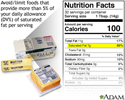Butter, margarine, and cooking oils
Cholesterol - butter; Hyperlipidemia - butter; CAD - butter; Coronary artery disease - butter; Heart disease - butter; Prevention - butter; Cardiovascular disease - butter; Peripheral artery disease - butter; Stroke - butter; Atherosclerosis - butterSome types of fat are healthier for your heart than others. Butter and other animal fats and solid margarine may not be the best choices. Alternatives to consider are liquid vegetable oil, such as olive oil.
What to Use When Cooking
When you cook, solid margarine or butter is not the best choice. Butter is high in saturated fat, which can raise your cholesterol. It can also increase your chance of heart disease. Some margarines have some saturated fat plus trans-fatty acids, which can also be bad for you. Both of these fats have health risks.
Saturated fat
Saturated fat is a type of dietary fat. It is one of the unhealthy fats, along with trans fat. These fats are most often solid at room temperature....

Some guidelines for healthier cooking:
- Use olive or canola oil instead of butter or margarine.
- Choose soft margarine (tub or liquid) over harder stick forms.
- Choose margarines with liquid vegetable oil, such as olive oil, as the first ingredient.
What Not to Use When Cooking
You should not use:
- Margarine, shortening, and cooking oils that have more than 2 grams of saturated fat per tablespoon (read the nutrition information labels).
- Hydrogenated and partially hydrogenated fats (read the ingredients labels). These are high in saturated fats and trans-fatty acids.
Partially hydrogenated fats
Trans fat is a type of dietary fat. Of all the fats, trans fat is the worst for your health. Too much trans fat in your diet increases your risk fo...
 ImageRead Article Now Book Mark Article
ImageRead Article Now Book Mark Article - Shortening or other fats made from animal sources, such as lard.
References
Arnett DK, Blumenthal RS, Albert MA, et al. 2019 ACC/AHA Guideline on the primary prevention of cardiovascular disease: Executive summary: A report of the American College of Cardiology/American Heart Association Task Force on Clinical Practice Guidelines. J Am Coll Cardiol. 2019;74(10):1376-1414. PMID: 30894319 pubmed.ncbi.nlm.nih.gov/30894319/.
Hensrud DD. Diet and nutrition. In: Goldman L, Cooney KA, eds. Goldman-Cecil Medicine. 27th ed. Philadelphia, PA: Elsevier; 2024:chap 13.
Mozaffarian D. Nutrition and cardiovascular and metabolic diseases. In: Libby P, Bonow RO, Mann DL, Tomaselli GF, Bhatt DL, Solomon SD, eds. Braunwald's Heart Disease: A Textbook of Cardiovascular Medicine. 12th ed. Philadelphia, PA: Elsevier; 2022:chap 29.
Ramu A, Neild P. Diet and nutrition. In: Naish J, Syndercombe Court D, eds. Medical Sciences. 3rd ed. Philadelphia, PA: Elsevier; 2019:chap 16.
-
Saturated fat - illustration
Saturated fat can raise blood cholesterol and can put you at risk for heart disease and stroke. You should limit your intake of any foods that are high in saturated fat. Sources of saturated fat include whole-milk dairy products, like cheese, ice cream and butter. Animal fats such as beef, pork or chicken, but not fish, are also high in saturated fats. Vegetable sources of saturated fat include coconut and palm oils. When looking at a food label, pay close attention to the percentage of saturated fat. The American Heart Association recommends aiming for a dietary pattern that achieves 5% to 6% of calories from saturated fat. For example, if you need about 2,000 calories a day, no more than 120 calories should come from saturated fats. This is equal to about 13 grams of saturated fat.
Saturated fat
illustration
-
Saturated fat - illustration
Saturated fat can raise blood cholesterol and can put you at risk for heart disease and stroke. You should limit your intake of any foods that are high in saturated fat. Sources of saturated fat include whole-milk dairy products, like cheese, ice cream and butter. Animal fats such as beef, pork or chicken, but not fish, are also high in saturated fats. Vegetable sources of saturated fat include coconut and palm oils. When looking at a food label, pay close attention to the percentage of saturated fat. The American Heart Association recommends aiming for a dietary pattern that achieves 5% to 6% of calories from saturated fat. For example, if you need about 2,000 calories a day, no more than 120 calories should come from saturated fats. This is equal to about 13 grams of saturated fat.
Saturated fat
illustration
Review Date: 8/5/2024
Reviewed By: Thomas S. Metkus, MD, Assistant Professor of Medicine and Surgery, Johns Hopkins University School of Medicine, Baltimore, MD. Also reviewed by David C. Dugdale, MD, Medical Director, Brenda Conaway, Editorial Director, and the A.D.A.M. Editorial team.


